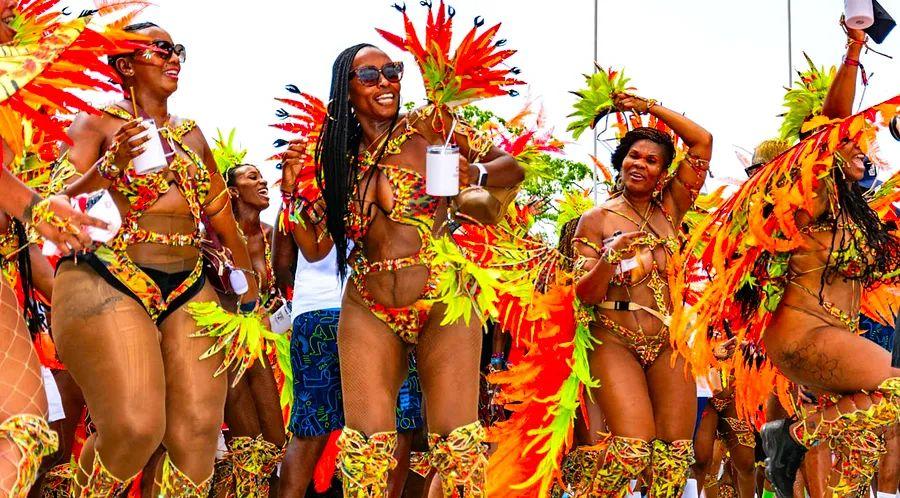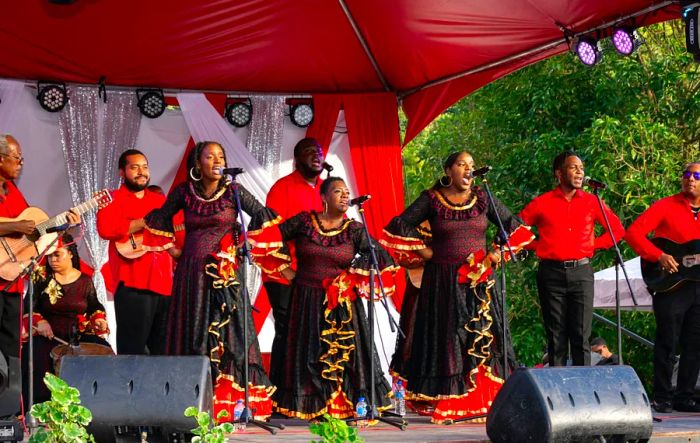A beginner's guide to Trinidad and Tobago

The dual-island nation of Trinidad and Tobago offers more than just a picturesque tropical escape.
The invigorating sea breeze, stunning beaches, and natural splendor are undeniable. However, the essence of life in Trinbago lies in its rich tapestry of people, places, and cultures. If you crave adventures infused with vibrant, pulsating energy, then the charm of T&T is perfect for you.
Here, warm locals cheerfully greet you by name during the lively Carnival festivities, and the art of partying—known locally as fêteing—is deeply ingrained in the community. Culinary enthusiasts will delight in unforgettable flavors. In Trinidad and Tobago, the celebration of history, unity, and culture makes your travel experience as serene or exhilarating as you desire.
 Parang music, influenced by Spanish traditions, is an essential part of the Christmas celebrations in Trinidad and Tobago. John de la Bastide/Shutterstock
Parang music, influenced by Spanish traditions, is an essential part of the Christmas celebrations in Trinidad and Tobago. John de la Bastide/ShutterstockWhen is the best time to visit Trinidad and Tobago?
In this region, you can enjoy year-round sunshine, with northeast trade winds providing a refreshing breeze to help you stay cool. Trinidad and Tobago has two distinct weather patterns: the dry season from January to May and the rainy season from June to December. The ideal time to visit T&T is during the January-to-April period, when temperatures are at their lowest. Although hurricane season spans from June to November, Trinidad and Tobago’s southern Caribbean location largely protects it from severe storms.
Cultural festivities occur year-round, but the Christmas season in December and the vibrant Carnival celebrations are the highlight of the festival calendar. Christmas in T&T features a lively soundtrack of parang, a cherished Spanish-inspired folk music that has its roots in neighboring Venezuela.
The famous Trinidad Carnival culminates on the Monday and Tuesday preceding Ash Wednesday, showcasing a cultural extravaganza filled with joy and celebration. Tobago also hosts its own exciting Carnival each year in October.
 Tranquil Tobago is abundant with stunning beaches and a laid-back lifestyle. Hugh Stickney/500px
Tranquil Tobago is abundant with stunning beaches and a laid-back lifestyle. Hugh Stickney/500pxHow long should I stay in Trinidad and Tobago?
It varies based on your resources, interests, and curiosities. To truly appreciate the beauty and vibrancy of this nation—and to allow time to explore both islands—spending seven nights would be ideal. This duration will enable you to experience the unique atmospheres of each island; we suggest four nights in Trinidad and three in Tobago. Known for its lively nightlife and extensive tourism, Trinidad contrasts sharply with the peaceful ambiance of Tobago, which boasts stunning ivory beaches and azure waters.
 You can hop between the islands of Trinidad and Tobago by taking a quick flight or riding a high-speed ferry. Shutterstock
You can hop between the islands of Trinidad and Tobago by taking a quick flight or riding a high-speed ferry. ShutterstockIs navigating Trinidad and Tobago easy?
Most travelers arrive by air, with international flights landing at Piarco International Airport in Trinidad. Tobago’s N.R. Robinson International Airport is just a short drive from the vibrant beach area of Crown Point.
Trinidad features a public transport system made up of 'maxi-taxis.' These passenger vans follow fixed routes, are marked with colored stripes indicating their operational areas, and can accommodate 12 to 25 passengers. The Public Transport Service Corporation runs public buses on both islands. Official taxis, marked with an 'H,' are available at the airports, along with various rideshare services such as AllRiDi, Travee, DeliverMe, and TT RideShare. Car rentals are also available, starting at around $40 per day.
The national airline, Caribbean Airlines, offers 25-minute flights between the islands for $70 round trip; alternatively, the local ferry can transport you from the Port of Spain to Scarborough for about $20 round trip.
 The beaches of Trinidad and Tobago are vital nesting sites for leatherback turtles, who return each year to lay their eggs in the sand. Jade Prevost Manuel/Shutterstock
The beaches of Trinidad and Tobago are vital nesting sites for leatherback turtles, who return each year to lay their eggs in the sand. Jade Prevost Manuel/ShutterstockMust-see attractions in Trinidad and Tobago
In addition to its stunning beaches (make sure to visit Maracas Beach), Trinidad and Tobago offers three distinctive experiences: its natural beauty, a diverse culinary scene shaped by its rich history, and a vibrant array of festivals celebrated throughout the year.
T&T's ecological treasures include the UNESCO-recognized Tobago Main Ridge Forest Reserve, the leatherback turtle nesting area at Matura Beach, and the renowned Asa Wright Nature Centre, which is home to countless native and migratory animal species.
Culinarily, the national favorite is a street-food classic known as doubles: lightly fried flatbread stuffed with a chickpea mixture, accompanied by condiments like tamarind sauce, homemade pepper sauce, or a refreshing cucumber chutney. Tobago’s signature dish is curry crab with dumplings, a wonderfully flavorful and hearty meal found at food stalls in Store Bay. The diverse culinary scene here, influenced by African, East Indian, Chinese, Indigenous, French, Spanish, Dutch, and English ingredients, offers a sophistication in both fine dining and street food that surpasses many other Caribbean nations.
Culture is always at the forefront on both islands. The captivating rhythms of soca music during Trinidad’s Carnival peak are truly enchanting. Meanwhile, Tobago celebrates its unique goat-racing festival in July, rich in tradition, alongside the Muslim festival of Hosay, featuring grand deity floats parading through the streets of St James in Port of Spain.
 Experiencing Carnival in Trinidad is a must-do. John de la Bastide/Shutterstock
Experiencing Carnival in Trinidad is a must-do. John de la Bastide/ShutterstockMy top activity in Trinidad and Tobago
Imagine 10,000 people joyfully dancing to the energetic beats of soca music blaring from mobile speakers mounted on a fleet of 16-wheeler trucks. Dressed in a dazzling costume adorned with feathers, you sip a refreshing cocktail from a tumbler handed to you by bartenders on a nearby mobile bar. The sun’s rays pale in comparison to the euphoric atmosphere of T&T’s grand national festival, a celebration rich in history that stretches back hundreds of years.
Welcome to Trinidad Carnival: a celebration of unrestrained freedom.
This festival transcends mere celebration; it embodies the vibrant and unique essence of this twin-island nation. From January to March each year, both experienced Carnival lovers and curious newcomers have the chance to engage in community traditions that bring the country together, regardless of creed, religion, or race. For many culture enthusiasts, the preparations for such a grand festival begin a year in advance, during the period known as 'band-launch season.'
Trinidad’s Carnival is a significant time of remembrance, honoring the long-standing contributions of the African community. It reflects the history of resistance and sacrifice that originated with enslaved Africans seeking freedom in the 18th century. Alongside traditional elements like stick fighting and authentic mas characters, the festive season includes continuous celebrations from dawn till dusk, showcasing events like the re-enactment of the Kambulé riots that led to emancipation.
The national festivities peak with a two-day parade on Carnival Monday and Tuesday. Centered around the Queen’s Park Savannah, this vibrant spectacle attracts tens of thousands of costumed masqueraders, creating an explosion of color, joy, and dancing through the streets of Port of Spain.
 Trinidadian cuisine is a remarkable fusion of culinary influences, featuring fresh fish, zesty sauces, and more, encapsulating the essence of the nation's culture. Shutterstock
Trinidadian cuisine is a remarkable fusion of culinary influences, featuring fresh fish, zesty sauces, and more, encapsulating the essence of the nation's culture. ShutterstockWhat’s the average budget needed for Trinidad and Tobago?
Travelers typically budget around $200 per day for their visit, though costs can rise significantly during busy seasons like Carnival.
Accommodations at well-known hotels start at about $225 per night. A more budget-friendly option is Airbnb rentals, which can begin around $75 per night during off-peak times. Bus and maxi-taxi fares start at $2, while rideshare prices vary based on distance. A dinner for two at a high-end restaurant might set you back at least $100 (we suggest treating yourself at Freebird in southern Trinidad). Conversely, at the popular Breakfast Shed with views of Port of Spain's harbor, you can enjoy a coffee for $3 and a sandwich for $5.
 When engaging with the locals in Trinidad and Tobago, remember to wear a smile. Sean Drakes/Getty Images
When engaging with the locals in Trinidad and Tobago, remember to wear a smile. Sean Drakes/Getty ImagesAdditional tips for enjoying Trinidad and Tobago
Trust local knowledge
Exploring Trinidad and Tobago with a local guide is always a wise choice. In rural areas, GPS can be unreliable, so it's best to gather information from your accommodation host, a neighbor, or a friend about how to reach specific locations before you head out.
Don’t forget to pack sunscreen and insect repellent.
Like in many tropical locations, protecting your skin in T&T is crucial. During the rainy season, mosquitoes can be quite prevalent, so using a strong insect repellent or placing netting over your bed will help keep bites at bay. With temperatures often exceeding 80°F (27°C), it's vital to stay hydrated, and sunscreen with at least SPF 30 is advisable for extended sun exposure.
Generosity costs nothing.
Above all, your smile is the most precious currency in Trinidad and Tobago. Whether you're relaxing at the beach or enjoying a drink at a bar, locals, or 'Trinis,' will eagerly engage you in friendly conversation and are always ready to ensure you have a wonderful time – a true reflection of the islands' hospitality.

1

2

3

4

5
Evaluation :
5/5